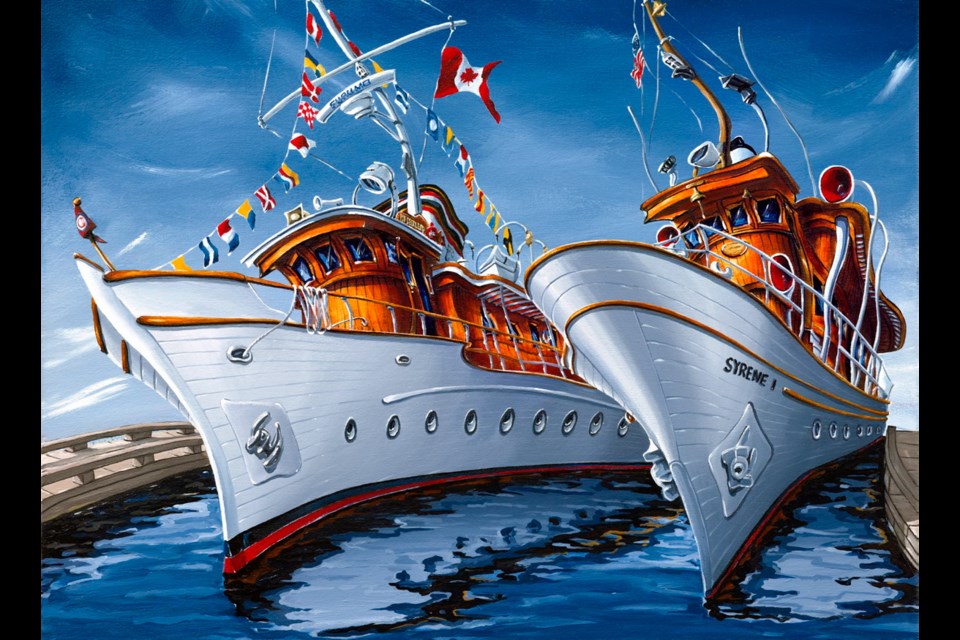 The season is over on the causeway, Victoria’s front window to the world. Because of the temporary nature of the displays of art and First Nations crafts, it might seem that the vendors there are birds of passage, stopping for few moments on their way to somewhere else. Can what’s created on the sidewalk be of much lasting value?
The season is over on the causeway, Victoria’s front window to the world. Because of the temporary nature of the displays of art and First Nations crafts, it might seem that the vendors there are birds of passage, stopping for few moments on their way to somewhere else. Can what’s created on the sidewalk be of much lasting value?
A visit with Marty Machacek recently gave me an insight into what’s happening there. Machacek is an artist I admire, with a distinctive style of twisted realism that he applies to all manner of local landmarks.
He has decided to move on, after manning his spot on the waterfront for eight years of full-time work, all day every day from May to October. To my surprise, he told me that some other vendors have spent more than 20 years on the causeway. Machacek and his wife Dana, who has worked with him there for many years, have saved up enough for a downpayment on a house at Cobble Hill, and are ready to reinvent their lives.
Born in Prague in the Czech Republic, Machacek grew up in Edmonton and, after studying commercial art, worked doing architectural renderings. By his talents, he earned enough to spend eight months of every year living in Prague training with a cycling team and as a triathlete.
“All my training rides were to castles and chateaux,” he told me. When he arrived at a scenic destination, he’d sit down and draw it before getting back on the bike and returning home. After a chance visit to Victoria to look after a friend’s dog, he decided to stay in this city.
Sketching on the causeway was a natural outgrowth of his plein air habits, and soon he had a bicycle trailer full of cards, prints and posters, which he brought downtown, in late April or as soon as the weather permitted. He was on the causeway every day, except when it rained and, as he reminded me, we have had some very dry summers lately.
There were seasons when he worked 60 days in a row. And those were long days, beginning before mid-morning and continuing until nightfall. At the time, the city required that vendors be on site personally every day, with only two hours off in a 12-hour period.
The hours were long, but sales were good. And in the back of his mind, Machacek had a dream.
“Maybe I’ll get discovered,” he thought. “Maybe an art dealer or rep will see me. Every day for the first three years, I didn’t want to miss anybody walking by. A few years went by, and I realized this was not going to happen.”
After he married, his wife, Dana, was able to spell him off for a few hours so he could do some errands and get some exercise. It took a concerted effort by them to get the city to change the regulations, allowing vendors to have a helper, and to take as much as four hours off in a 12-hour day.
Besides sales, Machacek was able to paint on the causeway, working on commissioned canvases for customers all over the world, but it took three times as long to do the work when he was out in public than when in his home studio in the off-season. Working on the waterfront wasn’t easy. Acrylics dry very fast out in the open, and he often had to stop to talk to people.
“I’m amazed at what I created down there,” he reminisced, “big, detailed paintings. Certain things I had to finish at home, so I’d put them in a box until winter. It was not ideal — not at all.”
“It’s loud down there,” he continued. “You always feel like there is somebody behind you.”
Having to explain himself all day long was a great drain on his psychic energy. People assumed his work is done with computer software and digital tricks. Repeatedly, they asked: “Do you have to drink, or smoke pot to do this?” But it was all done by hand. When the artist’s feelings were hurt, he internalized it. And he got tired of being on display.
“You end up almost putting this shield around yourself,” he sighed. “I had nothing left to give at the end of the year. My body needs to get rid of those walls, to let me become myself again.”
“Over the years, my work has turned a little bit to what people want, or what will sell,” Machacek said, “but the end result isn’t as rewarding for me. If I am not continually growing and evolving, I feel dead.”
It was clear that, for this artist, the causeway had served its purpose. Now it was time to let go of expectations.
“When you focus more on doing the work rather than the results, the things that you dream are more likely to come true,” he told me. To back up his dreams, he has a substantial body of work that is thoughtful and well-made.
Without the support of a string of galleries, in the future he’s likely to continue with commissioned work for customers who admire him.
“You can feel their excitement,” he said. “It builds within me, and I’m picking up on their energy.” While the causeway introduced him to a wide range of supporters, it excluded him from family and friends for a long time. Now Machacek is going to recreate himself — he’s ready to try something new.
For further information, go to martycultural.com



